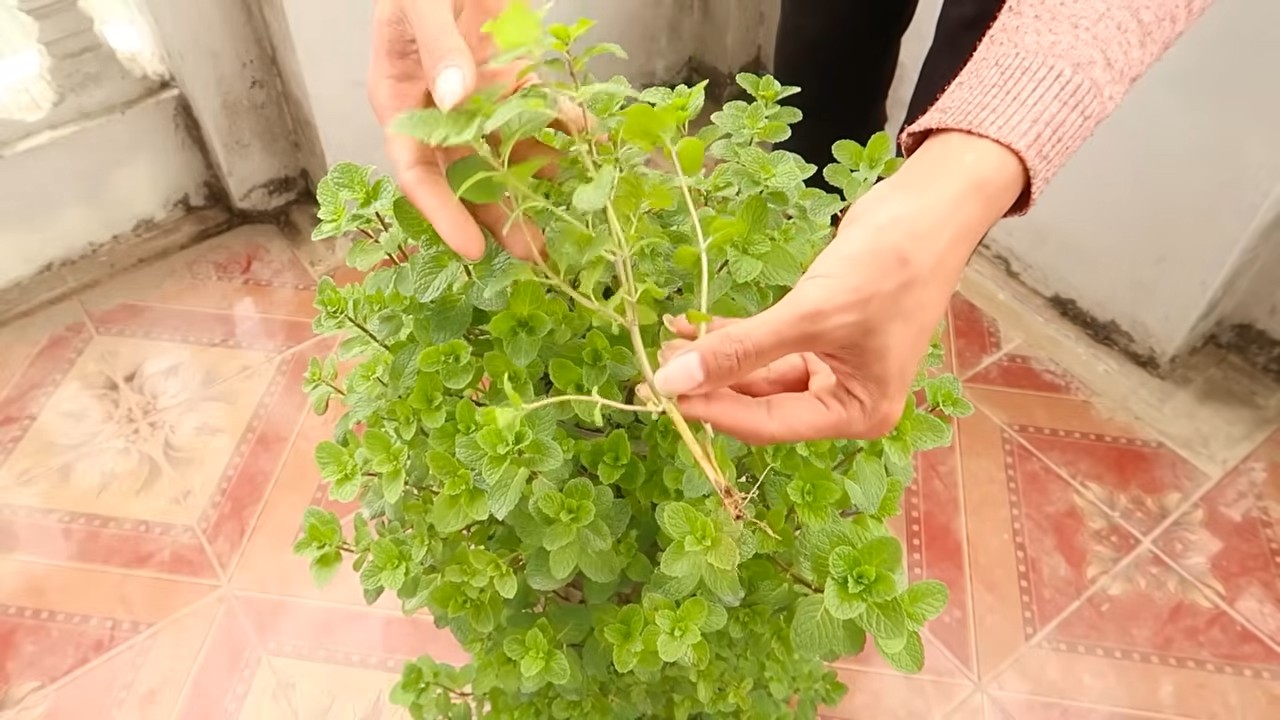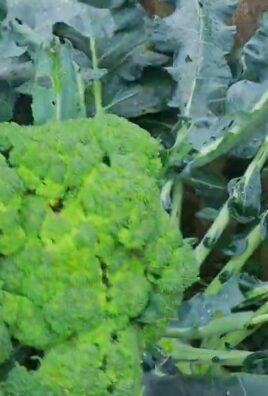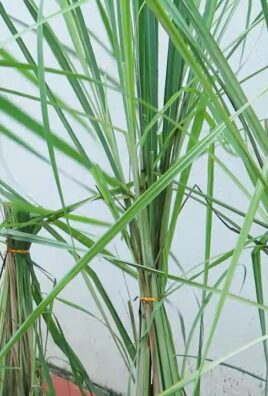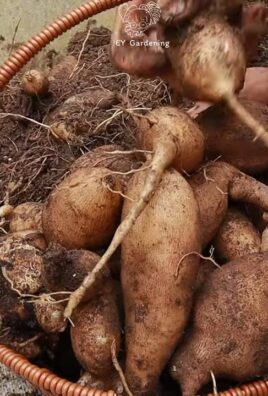Healthy Mint Plant Care doesn’t have to be a mystery! Have you ever dreamed of stepping outside your back door and snipping fresh, fragrant mint for a refreshing mojito or a soothing cup of tea? I know I have! But let’s be honest, sometimes growing mint can feel more like a battle than a blissful gardening experience. It can be invasive, it can get leggy, and sometimes, it just plain refuses to thrive.
Mint has been cherished for centuries, not just for its culinary uses, but also for its medicinal properties. Ancient Egyptians used it for embalming, and the Romans spread it throughout Europe, valuing it for its invigorating scent and digestive benefits. Today, we still appreciate mint for all these reasons, but wouldn’t it be amazing to cultivate a thriving mint patch without the usual headaches?
That’s where these DIY tricks and hacks come in! We’re going to dive into simple, effective strategies to ensure your mint plant flourishes, whether you’re a seasoned gardener or just starting out. From choosing the right container to mastering the art of pruning, I’ll share my secrets to achieving lush, vibrant healthy mint plant care. Say goodbye to struggling mint and hello to a bountiful harvest that will elevate your cooking, beverages, and even your home’s ambiance!

DIY: How to Properly Care for Your Mint – for a Lush Harvest!
I love mint! Whether in a mojito, in tea, or as a fresh ingredient in a salad – the aroma and taste are simply unbeatable. But growing a healthy, lush mint plant can sometimes be a bit of a challenge. Don’t worry, I’ll show you how it’s done! With these simple DIY tips and tricks, your mint is guaranteed to become the star of your herb garden or balcony.
The Basics: What Mint Really Needs
Before we get into the details, let’s briefly discuss the most important needs of your mint. This is the foundation for everything else:
- Sun: Mint loves the sun, but too much direct midday sun can burn its leaves. A partially shaded location is ideal.
- Water: Mint needs regular watering, especially on hot days. The soil should always be slightly moist, but not soggy.
- Soil: A well-draining, nutrient-rich soil is perfect for mint.
- Space: Mint is an invader! It’s best to plant it in a pot to prevent it from taking over your entire garden.
- Regular Pruning: This is the key to a bushy, healthy plant.
Planting Mint Correctly: Step by Step
Okay, let’s get started! Here is a detailed guide on how to plant your mint correctly:
- Choose the right pot: Select a pot with sufficient drainage holes. Mint does not like waterlogged soil. A pot with a diameter of at least 20 cm (about 8 inches) is ideal.
- Prepare the right soil: Mix high-quality potting soil with some compost or organic fertilizer. This ensures a good supply of nutrients. I like to use a mixture of 2 parts potting soil, 1 part compost, and a handful of horn shavings.
- Plant the mint: Fill the pot with the prepared soil. Make a hole in the center large enough for the mint’s root ball. Carefully place the mint in the hole and fill the pot with soil. Press the soil down lightly.
- Water it in: Water the mint thoroughly after planting. Make sure the water can drain away well.
Watering Mint Correctly: Here’s How You Do It!
Proper watering is crucial for healthy mint. Here are my tips:
- Water regularly: Water your mint regularly, especially on hot days. The soil should always be slightly moist, but not soggy.
- The finger test: Stick your finger into the soil. If the top layer feels dry, it’s time to water.
- Water in the morning: It’s best to water your mint in the morning. This gives the leaves time to dry before evening, which can prevent fungal diseases.
- Don’t water the leaves: Avoid watering the leaves directly. This can lead to fungal growth. Instead, water directly onto the soil.
- Pay attention to drainage: Ensure that water can drain well. Waterlogging can lead to root rot.
Fertilizing Mint Correctly: For a Lush Harvest
Although mint isn’t particularly demanding, regular fertilizing will ensure a lush harvest.
- Organic fertilizer: It’s best to use organic fertilizers like compost, horn shavings, or nettle tea.
- Liquid fertilizer: You can also use liquid fertilizer, but make sure it is suitable for herbs.
- Fertilize regularly: Feed your mint every 2-3 weeks during the growing season (spring and summer).
- Less is more: Don’t over-fertilize your mint. Too much fertilizer can lead to soft, susceptible leaves.
Pruning Mint Correctly: The Secret to a Bushy Plant
Regular pruning is the key to a healthy, bushy mint plant.
- Prune regularly: Cut your mint back regularly, even if you’re not using it. This encourages the growth of new shoots.
- The right technique: Cut the stems just above a leaf node. This stimulates the growth of new side shoots.
- Remove flowers: Remove the flowers as soon as they appear. This directs the plant’s energy into leaf growth.
- A big chop: If your mint becomes too long and sparse, you can also cut it back radically. Don’t worry, it will grow back quickly.
Overwintering Mint: How to Get It Through the Winter
Mint is hardy, but it needs some protection when in a pot.
- Location: Place your mint in a bright, cool place. An unheated conservatory or a cool stairwell is ideal.
- Water less: Water your mint only sparingly in winter. The soil shouldn’t dry out completely, but it shouldn’t be too moist either.
- Don’t fertilize: Do not fertilize your mint in the winter.
- Protect from frost: If it gets very cold, you can wrap the pot in burlap or fleece.
- Prune in spring: Cut your mint back in the spring before new growth starts.
Common Problems and Solutions
Even with the best care, problems can arise. Here are some common issues and how to solve them:
- Yellow leaves: Yellow leaves can be a sign of overwatering, nutrient deficiency, or pest infestation. Check your watering, fertilize your mint, and inspect it for pests.
- Brown leaves: Brown leaves can be caused by too much sun, dryness, or fungal attack. Move your mint to a partially shaded spot, water it regularly, and treat it with a fungicide if necessary.
- Pests: Mint can be affected by aphids, spider mites, or slugs. Combat pests with natural remedies like neem oil or insecticidal soap solution.
Propagating Mint: How to Get Even More Plants
Mint is very easy to propagate. Here are two methods:
- Cuttings: Cut a healthy shoot and place it in a glass of water. Roots will form after a few days. Then plant the cutting in a pot with soil.
- Division: Divide a large mint plant into several parts. Plant the individual parts in separate pots.
Harvesting and Using Mint: Freshness for Your Kitchen
The harvest is the best part!
- Harvest regularly: Harvest your mint regularly to encourage the growth of new shoots.
- The right time: It’s best to harvest your mint in the morning when the essential oils are most concentrated.
- The right technique: Cut the stems just above a leaf node.
- Use: Use your mint fresh in salads, drinks, desserts, or as a garnish. You can also dry or freeze it to preserve it for longer.
Extra Tip: Keeping Mint in Check in the Garden
As mentioned, mint is an invader. If you plant it in the garden, be sure to plant it in a large, bottomless pot or use a root barrier. Otherwise, you’ll soon have mint everywhere!
I hope these tips help you to care for your mint properly and achieve a lush harvest. Happy gardening!

Conclusion
So, there you have it! Mastering healthy mint plant care doesn’t require a green thumb or expensive gardening supplies. By implementing these simple yet effective DIY tricks, you’re well on your way to cultivating a thriving mint patch that will provide you with fresh, aromatic leaves for teas, culinary creations, and refreshing summer beverages. The key is understanding mint’s needs – its love for well-draining soil, its thirst for consistent moisture, and its appreciation for bright, indirect sunlight.
This isn’t just about growing a plant; it’s about creating a sustainable source of fresh herbs right at your fingertips. Imagine the satisfaction of snipping off a few sprigs of your own homegrown mint to add to a pitcher of iced tea on a hot day, or using it to create a vibrant mint chutney to accompany your favorite Indian dishes. The possibilities are endless!
Don’t be afraid to experiment with different varieties of mint. Peppermint, spearmint, chocolate mint, and even pineapple mint each offer unique flavors and aromas that can add a delightful twist to your culinary adventures. Consider planting them in separate containers, as mint is known for its vigorous growth and can quickly take over a garden bed if left unchecked. You can also try propagating your mint plants from cuttings to expand your collection or share with friends and family.
Remember, consistent care is crucial. Regularly check the soil moisture, prune your plants to encourage bushier growth, and keep an eye out for any signs of pests or diseases. With a little attention and these DIY techniques, you’ll be amazed at how quickly your mint plants flourish.
We encourage you to give these healthy mint plant care tips a try. Whether you’re a seasoned gardener or a complete beginner, you’ll find that growing mint is a rewarding and enjoyable experience. And most importantly, don’t be afraid to get your hands dirty! Gardening is all about learning and experimenting.
We’d love to hear about your experiences! Share your successes, challenges, and any variations you’ve tried in the comments below. Let’s create a community of mint enthusiasts who can learn from each other and celebrate the joys of homegrown herbs. Happy gardening!
Frequently Asked Questions (FAQ)
Why is my mint plant turning yellow?
Yellowing leaves on your mint plant can indicate several issues. Overwatering is a common culprit, as it can lead to root rot. Ensure your pot has adequate drainage and allow the soil to dry slightly between waterings. Underwatering can also cause yellowing, so check the soil moisture regularly. Nutrient deficiencies, particularly nitrogen, can also lead to yellowing. Consider using a balanced liquid fertilizer diluted to half strength to provide your mint plant with the nutrients it needs. Finally, pests like spider mites can suck the sap from the leaves, causing them to yellow. Inspect your plant carefully for any signs of infestation and treat accordingly with insecticidal soap or neem oil.
How often should I water my mint plant?
The frequency of watering depends on several factors, including the size of your pot, the type of soil, and the climate. As a general rule, water your mint plant when the top inch of soil feels dry to the touch. During hot, dry weather, you may need to water more frequently, perhaps every day or every other day. In cooler weather, you can water less often, perhaps once or twice a week. Avoid overwatering, as this can lead to root rot. A good way to check if your plant needs water is to stick your finger into the soil. If the soil feels dry, it’s time to water.
What kind of soil is best for mint plants?
Mint plants thrive in well-draining soil that is rich in organic matter. A good potting mix for mint plants should contain a blend of peat moss, perlite, and vermiculite. You can also add compost or other organic matter to improve the soil’s fertility and drainage. Avoid using heavy clay soils, as they can retain too much moisture and lead to root rot. If you are planting mint in the ground, amend the soil with compost or other organic matter to improve its drainage and fertility.
How much sunlight does my mint plant need?
Mint plants prefer bright, indirect sunlight. They can tolerate some direct sunlight, but too much direct sun can scorch the leaves. If you are growing mint indoors, place it near a sunny window that receives at least 4-6 hours of indirect sunlight per day. If you are growing mint outdoors, choose a location that receives morning sun and afternoon shade.
How do I prune my mint plant?
Pruning is essential for maintaining a healthy and productive mint plant. Regular pruning encourages bushier growth and prevents the plant from becoming leggy. To prune your mint plant, simply pinch off the top leaves and stems. You can also cut back the entire plant by about one-third to encourage new growth. Prune your mint plant regularly throughout the growing season to keep it healthy and productive. You can use the pruned leaves for cooking, teas, or other culinary purposes.
Why is my mint plant not growing?
Several factors can contribute to a mint plant’s lack of growth. Insufficient sunlight is a common reason. Ensure your plant receives adequate bright, indirect light. Nutrient deficiencies can also stunt growth. Fertilize your mint plant regularly with a balanced liquid fertilizer. Overwatering or underwatering can also inhibit growth. Check the soil moisture regularly and water accordingly. Finally, pests or diseases can also affect growth. Inspect your plant carefully for any signs of infestation or disease and treat accordingly.
Can I grow different types of mint together?
While it’s tempting to grow different mint varieties together, it’s generally not recommended. Mint plants are known for their aggressive growth habits and can easily cross-pollinate, resulting in unpredictable flavors and aromas. It’s best to grow different types of mint in separate containers to prevent them from mixing. This will also allow you to control their spread and maintain their distinct characteristics.
How do I propagate mint plants?
Mint plants are incredibly easy to propagate from cuttings. Simply take a 4-6 inch cutting from a healthy stem, remove the lower leaves, and place the cutting in a glass of water. Within a few weeks, roots will begin to form. Once the roots are about an inch long, you can transplant the cutting into a pot filled with well-draining potting mix. Keep the soil moist until the plant is established. You can also propagate mint by dividing the roots. Simply dig up the plant and separate the roots into smaller clumps. Replant the clumps in separate pots or in the ground.
How do I deal with pests on my mint plant?
Mint plants can be susceptible to pests like spider mites, aphids, and whiteflies. Inspect your plant regularly for any signs of infestation. If you find pests, you can treat them with insecticidal soap or neem oil. These are natural and effective ways to control pests without harming your plant. You can also try washing the leaves with a strong stream of water to dislodge the pests.
Is mint safe for pets?
While mint is generally considered safe for pets in small quantities, it’s important to be aware that some types of mint, such as pennyroyal, can be toxic to pets if ingested in large amounts. It’s always best to consult with your veterinarian before giving your pet any herbs or plants. If you suspect that your pet has ingested a toxic amount of mint, contact your veterinarian immediately.




Leave a Comment